Guantanamo documents reveal US brutality and lawlessness

A detainee peers through a plastic window in Camp Iguana detention
facility on the U.S. Naval Base in Guantánamo Bay, Cuba, Wednesday,
Nov. 19, 2008. (AP/Brennan Linsley)
A new trove of documents released Sunday night by WikiLeaks profiles more than 700 prisoners who passed through the Guantanamo Bay detention camp between 2002 and 2009. The documents demonstrate that, even in the eyes of the US military/intelligence apparatus, there was no evidence connecting the vast majority of the prisoners to any form of terrorism, let alone terrorist threats against the United States and US citizens.
The documents consist largely of Detainee Assessment Briefs (DABs), short summaries of the alleged evidence against individual detainees, as well as accounts of their physical and mental health, how they came into US custody, their value as intelligence sources and their eventual disposition, if any. Along with the DABs on 704 prisoners—out of 779 men believed to have been imprisoned at Guantanamo for any length of time—there are documents providing guidelines for interrogators and other procedures at the US-run prison camp in Cuba.
The documents require careful review, but certain preliminary conclusions can be drawn immediately from the digests which have appeared in a dozen newspapers and magazines, some of which are collaborating with WikiLeaks and others which are openly hostile to the whistle-blower web site. There is also a useful summary posted on WikiLeaks itself (http://wikileaks.ch/gitmo/).
Few of the DABs contain any detail on the interrogation techniques practiced by US torturers at CIA “black prisons,” before the victims arrived at Guantanamo, or at Guantanamo itself. But there are several references to torture, without using that word, perpetrated by US allies on a contract basis. Thus, Australian prisoner Mamdouh Habib is described as having undergone “severe duress” at an Egyptian prison before he was sent to Guantanamo. During those interrogations, he made the absurd claim to having personally trained in martial arts six of the 19 terrorists who perpetrated the September 11, 2001 attacks.


























